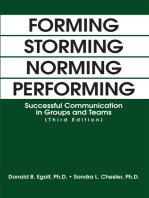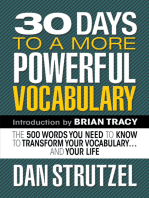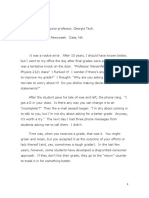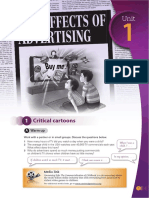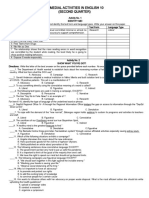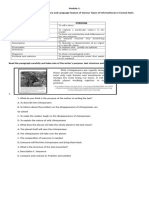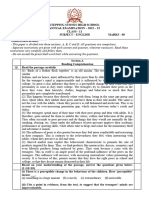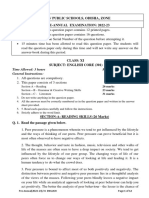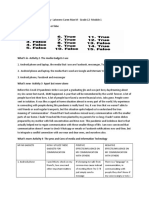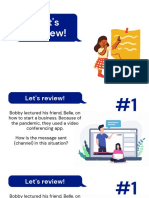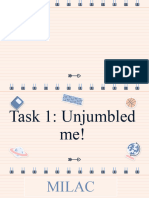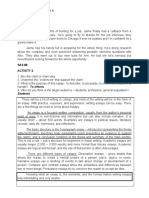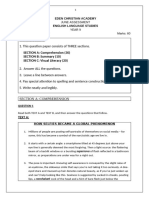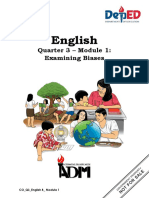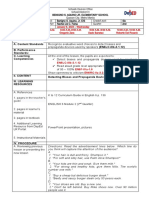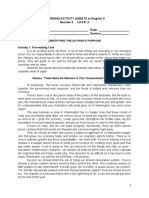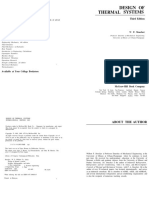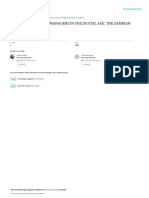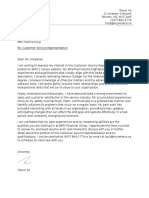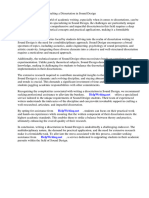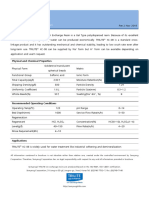The Effects of Advertising: Critical Cartoons
The Effects of Advertising: Critical Cartoons
Uploaded by
Ahmad AbdCopyright:
Available Formats
The Effects of Advertising: Critical Cartoons
The Effects of Advertising: Critical Cartoons
Uploaded by
Ahmad AbdOriginal Title
Copyright
Available Formats
Share this document
Did you find this document useful?
Is this content inappropriate?
Copyright:
Available Formats
The Effects of Advertising: Critical Cartoons
The Effects of Advertising: Critical Cartoons
Uploaded by
Ahmad AbdCopyright:
Available Formats
Cambridge University Press
978-1-107-62709-3 – In Focus Level 1
Charles Browne Brent Culligan and Joseph Phillips
Excerpt
More information
THE EFFECTS OF
1
Unit
ADVERTISING
1 Critical cartoons
A Warm up
Work with a partner or in small groups. Discuss the questions below.
1 How many hours of TV did you watch a day when you were a child? When I was a
2 The average child in the USA watches over 40,000 TV commercials each year. child, I . . .
What effect does this have?
3 Why do advertisers spend so much money putting commercials
on children’s TV shows when children have so little money?
In my opinion, . . .
If children watch so much TV, it must . . . I think one reason is . . .
Media link
Consuming Kids: The Commercialization of Childhood is a documentary about
the multi-billion dollar industry that sells everything from junk food to
violent video games to children.
For additional media links, go to www.cambridgeinfocus.org
© in this web service Cambridge University Press www.cambridge.org
Cambridge University Press
978-1-107-62709-3 – In Focus Level 1
Charles Browne Brent Culligan and Joseph Phillips
Excerpt
More information
UNIT 1
2 Core vocabulary
A Scanning and skimming
1 Find and underline the keywords in the text. The first one is done for you. Try to
guess their meanings.
Keywords
assume behavior brand income industry
label prevent stock trend warn
Advertising is used in many ways. Health experts use
advertising to warn the public against bad things. For
example, they want to prevent young people from
starting to smoke. They assume that young people won’t
5 start if they know how bad smoking is. Sometimes, health
organizations may want to change people’s behavior –
getting them to exercise more, for example.
However, advertising is more often used by industry to
sell things. A company’s income depends on how much
10 money it makes by selling its products and services. These
days, the trend is for companies to advertise their brand.
A brand is a mark, a name, or a label that stands for a Wear the label and feel good
company’s products or services. In the past, a clothing
company would advertise a coat or clothing. Nowadays, a company might
15 advertise how people feel when they wear its label. In this way, the company
develops “brand loyalty.” That is when people like to buy only the products from
one brand. Then the company can charge more money for its products. Investors
in companies like brand loyalty very much because the price of their stock goes up
when a company has a strong brand.
2 Read the statements below. Which best describes what this text
is about?
A The uses of advertising in society
B The positive effects of brand loyalty
C How advertising can be used to improve our health
2
© in this web service Cambridge University Press www.cambridge.org
Cambridge University Press
978-1-107-62709-3 – In Focus Level 1
Charles Browne Brent Culligan and Joseph Phillips
Excerpt
More information
UNIT 1
B Words in context: identifying a part of speech
1 Look at the text on page 2. Three of the keywords are verbs. Verbs describe an
action. Find the verbs and write them below.
1
2
3
2 The subject of the sentence is the same for all three verbs. Write it below.
3 Use the three verbs to make your own sentences.
1
2
3
C Word parts: ism Example: consumerism
1 Find five words with ism in the puzzle and D T U W D G R Z U S W
circle them. Check their meanings. See page 97 C O N S U M E R I S M
if you need help.
C B S N F I U M S S V
2 Complete the sentences below with the words
O N A V O B S F I X F
from the puzzle. M Z L N H I P R I D N
M L L E E M O F Y J J
1 There have been many acts of
U T Y H O R B U I Y H
in the twenty-first century.
2 is a belief that there is no god. N J T V R V K A U R C
3 Many universities offer courses in I A G E E J X M M K A
. S Z T R M F P X O K X
4 Advertising encourages M E N F E M I N I S M
in society.
5 in Eastern Europe ended in
the 1990s.
3 Work with a partner. What do you think ism means? Circle the correct answer.
A an outdoor activity
B a belief or system of beliefs
C thinking too much about something
D Discussion dictation
1 Listen and write down the questions.
1 What were ?
2 What are ?
3 Are cigarettes ?
2 Work with a partner. Ask each other the questions. Be sure to ask follow-up
questions.
© in this web service Cambridge University Press www.cambridge.org
Cambridge University Press
978-1-107-62709-3 – In Focus Level 1
Charles Browne Brent Culligan and Joseph Phillips
Excerpt
More information
UNIT 1
3 Reading skills
A Pre-reading questions
1 Have you ever bought a product because of an advertisement you saw?
What was it? Why did you buy it?
2 What is one positive effect and one negative effect of advertising?
B Reading
Read the text. Highlight an interesting idea in each paragraph.
You Are What You Buy
Over the last 60 or 70 years,
consumerism has been a trend
in developed countries. People
buy things they do not need, and
5 they replace things before they
wear out. (1) We used to repair
things when they were broken, but
today we throw out old things and
replace them with new models.
10 Indeed, many of the things we use
cannot be repaired. Once, products were made to last for
many years. Now, they are designed to last only a few years.
Advertising supports this behavior of buying things that we do
not really need. Advertisements (or ads) make us notice products and brands by having
15 them repeatedly appear in our lives, especially on television. (2) There are many interesting
programs on television. The advertising industry tells us that to be happy we need this or that
product in our lives. It does this with images that connect the product to happy, successful,
or beautiful people. We assume that to be successful or happy, we must buy the product or
brand or we must wear the same designer label as the beautiful, successful people in the
20 advertisement.
The negative results of this consumerism are easy to see. (3) As people spend more and
more of their income on things they do not need, they have to work more to pay for them.
This prevents people from spending time with their family or spending money on education
or healthy food. In America today, there are more shopping centers than high schools, and
25 parents spend about 6 hours per week shopping but only 40 minutes playing with their
children.
Another negative result is that we become more tolerant of lies and half-truths. To increase
profits and stock prices, companies make many false claims about their products. Can we
really lose weight simply by taking a pill, without dieting or exercising?
30 People also warn us of the negative effects of consumerism on the environment. (4) We use
energy to produce these unnecessary goods, and that energy use puts more CO2 into the
air and causes climate change. When we throw away goods, they are either burned or
buried, again causing damage to the environment.
Advertisers say that all they do is inform us. But in reality they have tricked us into working
35 longer hours, buying stuff we don’t need, and thinking we need their products to impress
others.
4
© in this web service Cambridge University Press www.cambridge.org
Cambridge University Press
978-1-107-62709-3 – In Focus Level 1
Charles Browne Brent Culligan and Joseph Phillips
Excerpt
More information
UNIT 1
C Identifying topic and main idea
Read the questions below and circle the correct answers according to the text.
1 Which of the following best describes the topic of the text?
A Shopping
B Consumerism
C Fashion brands
D Money
2 Which of the following best describes the main idea of the text?
A Buying fashionable goods affects how people feel.
B Modern products are not designed to last.
C Advertising influences people’s behavior in negative ways.
D Consumerism has effects on the environment.
D Identifying unnecessary information
1 Look at the four numbered sentences in the passage. Which contains information
that is not related to the main point of the author?
Sentence number:
Reason it is not necessary:
2 Compare your answers with a partner.
E Identifying opinions
Which one of the following sentences best describes the author’s opinion?
Circle A, B, or C.
A Advertising causes us to buy too many things, and this has many negative results.
B Advertising is neither good nor bad; people are free to choose not to buy things.
C Advertising is a useful way to find out about a product.
Going beyond the text
Work with a partner or in small groups. Ask and answer the questions below.
1 Look back at the ideas you highlighted. Are they the same? What are the differences?
2 You have 3 minutes. How many different ways of advertising can you think of?
For example, newspaper advertisements are one way.
3 Imagine you want to buy these items:
• a mobile phone • a pair of shoes • a pizza
How important is advertising to you when you decide to buy these things?
© in this web service Cambridge University Press www.cambridge.org
Cambridge University Press
978-1-107-62709-3 – In Focus Level 1
Charles Browne Brent Culligan and Joseph Phillips
Excerpt
More information
UNIT 1
4 Find out more
A Information gathering
Work in small groups. Find at least five advertisements. If you can, use the Internet to
search for popular advertisements. Write notes about each one in the chart below.
Why the ad appeals
Advertisement Product Target group
to the target group
photo of Kobe Bryant is strong, cool, and
Nike Young people
Kobe Bryant good-looking.
B Comparing results
Form new groups and compare your advertisements. Discuss the questions below.
1 How many of these products do you buy? How do you feel about them?
2 What words can you think of to describe the products?
3 Do the makers of any of these products use a celebrity spokesperson to advertise?
Which makers? Does this make you want to buy the product?
4 Do any of the products use humor to sell the product? Which ones? Does this make you
feel more positive about the product?
I think the advertisement for . . .
is original / funny / memorable / The ad suggests / appeals to / features . . .
romantic / eye-catching / feminine
I like the way some
Some / quite a few ads use celebrities. advertisements . . .
An example is . . . , which uses . . .
© in this web service Cambridge University Press www.cambridge.org
Cambridge University Press
978-1-107-62709-3 – In Focus Level 1
Charles Browne Brent Culligan and Joseph Phillips
Excerpt
More information
UNIT 1
5 Critical thinking
A What does the author mean? inference: a guess
that something is
true or not from the
1 Work with a partner. Read the statements below and decide information you have
if they are suggested by the text on page 4. Write down your
reasons.
Inference? Where
Statement
(Yes/No) (line no.)
1 In the past, products were of a higher quality.
2 Consumerism causes parents to spend less time with
their children.
3 Advertisements are a reliable source of information.
4 Advertising makes people assume that they will find
happiness if they buy something.
2 Compare your answers with a new partner.
B Categorizing
Read the statements below about some of the effects of advertising. Decide if they
sound positive or negative. Check (✔) the boxes. Then compare your answers with
a partner.
Advertising . . . Positive Negative
creates more waste.
means people have to work harder.
increases company profits.
leads to less time with family.
gives more information to customers.
changes bad behavior.
C Tweet your opinion
1 Work with a partner or in small groups. Here are some
common advertising techniques. Explain what you know
about each technique.
1 Comparing products 5 Selling top-quality products
2 Using creativity at a high price tweet: a very short
message posted online
3 Recommendation or 6 Focusing on lifestyle using the social media
appeal by a famous person 7 Selling at a low price site Twitter
4 Using fear 8 Using scientific research
2 Which techniques are popular in your country?
Which do you think are most effective? Write a Tweet
tweet with your opinion. Use the model on the Here, a popular technique is . . .
right.
The most effective one is . . .
© in this web service Cambridge University Press www.cambridge.org
Cambridge University Press
978-1-107-62709-3 – In Focus Level 1
Charles Browne Brent Culligan and Joseph Phillips
Excerpt
More information
UNIT 1
D Discussion
1 Work in small groups. In C, you looked at eight advertising techniques. Read these
statements taken from advertisements. Which techniques do they use? Write 1 to 8
in the chart below.
Technique
Advertising statement
(1–8)
1 Tests showed a 69% improvement after using Brand A.
2 Mouthwash A is better than Mouthwash B.
3 Tiger Woods loves to use Brand Z.
4 30% off Brand X this week
5 Smoking shortens your life by 10 years.
6 Enjoy your life. Drive an XYZ and feel free.
2 Another advertising technique is called “greenwashing.” This is when advertisers
say their product is good for the environment in order to increase sales. Look at
the advertisement below and discuss the questions in your groups.
1 What is this advertisement for?
2 Do you think the ad is effective? Does it
make you more likely to buy the product?
3 What things does the ad NOT say about
this product?
4 Why could this be an example of
greenwashing?
5 Can you think of any other examples of
greenwashing?
Although the ad is probably
telling the truth, I think . . .
This could
ld bbe an example
l
of greenwashing because . . . The ad doesn’t say Another example of
anything about . . . greenwashing is . . .
Quotable Quotes
Final thoughts . . .
Advertising is legalized* lying.
H. G. Wells
English writer
1 Do you think that advertisements sometimes lie?
Give examples.
2 Do you think there should be laws on what and how products
are advertised? Give examples.
*legalized allowed by law
8
© in this web service Cambridge University Press www.cambridge.org
You might also like
- Forming Storming Norming Performing: Successful Communication in Groups and Teams (Third Edition)From EverandForming Storming Norming Performing: Successful Communication in Groups and Teams (Third Edition)No ratings yet
- National Annex EC8Document39 pagesNational Annex EC8nurul.adilah1103No ratings yet
- 30 Days to a More Powerful Vocabulary: The 500 Words You Need to Know to Transform Your Vocabulary.and Your LifeFrom Everand30 Days to a More Powerful Vocabulary: The 500 Words You Need to Know to Transform Your Vocabulary.and Your LifeRating: 4 out of 5 stars4/5 (15)
- Effective ClaimsDocument7 pagesEffective ClaimsCarmela EstocadoNo ratings yet
- 4.10. The Data in Table 4.4 Are To Be Fit To An Eq...Document1 page4.10. The Data in Table 4.4 Are To Be Fit To An Eq...Ahmad AbdNo ratings yet
- 8 Final English Grade 9 Week 8 Second QuarterDocument10 pages8 Final English Grade 9 Week 8 Second QuarterMay SalomabaoNo ratings yet
- Making The GradeDocument4 pagesMaking The Gradejuancho1994No ratings yet
- Assignment - Child Psychology - Muhammad AmarDocument28 pagesAssignment - Child Psychology - Muhammad AmarNurul Syahirah Mohamad AliNo ratings yet
- In Focus SB1 - Unit 1Document8 pagesIn Focus SB1 - Unit 1Jack MagicNo ratings yet
- Remedial Activities in English 10Document3 pagesRemedial Activities in English 10Jennelyn Sulit100% (1)
- Module 2Document9 pagesModule 2jericaeraresurreccionNo ratings yet
- EnglishDocument16 pagesEnglishNoel PiedadNo ratings yet
- 2nd Term 3rd Year Test Sci - STRDocument3 pages2nd Term 3rd Year Test Sci - STRAZ AMNo ratings yet
- Syarifah Vocabulary2cDocument3 pagesSyarifah Vocabulary2csyarifah farihahNo ratings yet
- English Reading III Part 1Document28 pagesEnglish Reading III Part 1egsusie.suiNo ratings yet
- Purposive ActivitiesDocument4 pagesPurposive Activities2021160No ratings yet
- CC MidtermDocument5 pagesCC MidtermOlisaemeka AniNo ratings yet
- QP Class 11 AE2023Document7 pagesQP Class 11 AE2023Aleena madhuNo ratings yet
- Eng8 Q3 M3 M3 LA PT MERGEDDocument23 pagesEng8 Q3 M3 M3 LA PT MERGEDLanamhae CuevasNo ratings yet
- English Practic Paper-1 QPDocument14 pagesEnglish Practic Paper-1 QPkushanyadav3848No ratings yet
- English Topic 1 Sem 3Document22 pagesEnglish Topic 1 Sem 3adlinadamia.apliiNo ratings yet
- READING & WRITING Mod9.pdf - 20230301 - 234125 - 0000Document17 pagesREADING & WRITING Mod9.pdf - 20230301 - 234125 - 0000Alfie LacidaNo ratings yet
- What I KnowDocument6 pagesWhat I KnowMariam GamosNo ratings yet
- Question (Xi Eng)Document12 pagesQuestion (Xi Eng)Shivansh NayakNo ratings yet
- ISE III Sample Paper 3 (With Answers)Document13 pagesISE III Sample Paper 3 (With Answers)Berto Parga PenaNo ratings yet
- Guía 2022Document67 pagesGuía 2022Antonio CruzNo ratings yet
- Englis8 q3 w1 Evaluatingnarrativesbasedonhowtheauthordevelopedtheelementsetting Domngal Baguio FinalDocument17 pagesEnglis8 q3 w1 Evaluatingnarrativesbasedonhowtheauthordevelopedtheelementsetting Domngal Baguio FinalSa RahNo ratings yet
- First DemoDocument5 pagesFirst DemoRonilo Bernal DaulongNo ratings yet
- Second Sem-Week 1Document11 pagesSecond Sem-Week 1Caren mae LatoneroNo ratings yet
- 阅读专题6Document14 pages阅读专题6ericpan041020No ratings yet
- EN8 THIRD Q ExamDocument3 pagesEN8 THIRD Q ExamMichelle CabahugNo ratings yet
- English 8 Q4 ModuleDocument38 pagesEnglish 8 Q4 ModulecesianeNo ratings yet
- Lecture 1-3 Functions of CommunicationDocument32 pagesLecture 1-3 Functions of CommunicationHipulan Am-amNo ratings yet
- Level:3ASS/GE/M December 2019 English Exam (First Term) : Adapted From S. Beder, 'A Community View'1998, Pp. 101-111Document3 pagesLevel:3ASS/GE/M December 2019 English Exam (First Term) : Adapted From S. Beder, 'A Community View'1998, Pp. 101-111Dina GsNo ratings yet
- Types of ClaimsDocument79 pagesTypes of ClaimsStanlee Mariano100% (1)
- SAS #7 Activity #4: Jandayan, Danicka Rutchel G. Bsmls 1-CDocument4 pagesSAS #7 Activity #4: Jandayan, Danicka Rutchel G. Bsmls 1-CDanicka Rutchel JandayanNo ratings yet
- EvaluationDocument3 pagesEvaluationLuis Magdamit Jr.No ratings yet
- GRADE 11 & 12 Division Parallel Assessment Reading and WritingDocument5 pagesGRADE 11 & 12 Division Parallel Assessment Reading and WritingIan JamesNo ratings yet
- English8 Q4 Exam FinalsDocument14 pagesEnglish8 Q4 Exam Finalscriselda.barbechoNo ratings yet
- Rainbow: ParagraphDocument10 pagesRainbow: Paragraphsanskritisangeet23No ratings yet
- ImportantDocument2 pagesImportantbefeti7455No ratings yet
- Unit9 Reading&WritingDocument37 pagesUnit9 Reading&WritingNguyễn Kim NgânNo ratings yet
- Say Whether The Following Statements Are True or FalseDocument4 pagesSay Whether The Following Statements Are True or FalseMohamed MidouNo ratings yet
- English Q3 AssessmentDocument8 pagesEnglish Q3 Assessmentaernda aentNo ratings yet
- Yr 9 June 2024 English AssessmentDocument8 pagesYr 9 June 2024 English AssessmentVannessaNo ratings yet
- English7 Q4 W4 Mod4 PDFDocument16 pagesEnglish7 Q4 W4 Mod4 PDFcarlo lucidoNo ratings yet
- English 8 Quarter 3 Week 3Document17 pagesEnglish 8 Quarter 3 Week 3Ann Jorquia100% (1)
- Make A Difference: ListeningDocument5 pagesMake A Difference: ListeningMargarida MendonçaNo ratings yet
- Q2 M3.revalidatedDocument12 pagesQ2 M3.revalidatedDennis Douglas Alo Jr.No ratings yet
- Q3-Pre TestDocument1 pageQ3-Pre TestIrish Carretero AustriaNo ratings yet
- MODULE 3. SHS MIL - Q1 - W3 - Responsible Use of Media and InformationDocument8 pagesMODULE 3. SHS MIL - Q1 - W3 - Responsible Use of Media and InformationAndrea Mangabat100% (1)
- English8 Q3 Mod1 ExaminingBiases V4Document24 pagesEnglish8 Q3 Mod1 ExaminingBiases V4SherivieMendonza100% (1)
- Russie T. Edaño 12-STEMDocument7 pagesRussie T. Edaño 12-STEMMer VinNo ratings yet
- Third Quarter Exams in Grade 8 EnglishDocument3 pagesThird Quarter Exams in Grade 8 EnglishJason Pastera100% (5)
- Quarter 3 Week 2 English 9Document21 pagesQuarter 3 Week 2 English 9Ace AntonioNo ratings yet
- DLP-Dec. 14-ENGDocument4 pagesDLP-Dec. 14-ENGJoi Faina100% (2)
- Las 2-4th QuarterDocument5 pagesLas 2-4th QuarterPearl Ann Coralde QuijanoNo ratings yet
- Las - 4th QuarterDocument5 pagesLas - 4th QuarterPearl Ann Coralde Quijano100% (1)
- Claims, Expressions The Affirm and Negate, Critical Thinking and T and O DefinitionsDocument84 pagesClaims, Expressions The Affirm and Negate, Critical Thinking and T and O DefinitionsjosemartinezNo ratings yet
- Herd: How to Change Mass Behaviour by Harnessing Our True NatureFrom EverandHerd: How to Change Mass Behaviour by Harnessing Our True NatureRating: 3.5 out of 5 stars3.5/5 (7)
- Power Teams Beyond Borders: How to Work Remotely and Build Powerful Virtual TeamsFrom EverandPower Teams Beyond Borders: How to Work Remotely and Build Powerful Virtual TeamsNo ratings yet
- SUMMARY Of The Culture Code: The Secret Of Highly Successful GroupsFrom EverandSUMMARY Of The Culture Code: The Secret Of Highly Successful GroupsNo ratings yet
- Thermo Chapter 6 ExamplesDocument1 pageThermo Chapter 6 ExamplesAhmad AbdNo ratings yet
- ACFrOgAlSbXHol7X5DCh7AxhfktcUDPYrfN3azOCdL8n w0uIfRwG5eExpx5o5M39eBr6flbL4jKbJQr5lHThcZBkyXMxp-ToA0tTBR4-0kpI 0Pvs52jZmo JZy6vTDinXL3OiGxJSHKeOq WwoDocument290 pagesACFrOgAlSbXHol7X5DCh7AxhfktcUDPYrfN3azOCdL8n w0uIfRwG5eExpx5o5M39eBr6flbL4jKbJQr5lHThcZBkyXMxp-ToA0tTBR4-0kpI 0Pvs52jZmo JZy6vTDinXL3OiGxJSHKeOq WwoAhmad AbdNo ratings yet
- Measurements: InstructorDocument42 pagesMeasurements: InstructorAhmad AbdNo ratings yet
- Thermo Chapter 6 ExamplesDocument5 pagesThermo Chapter 6 ExamplesAhmad AbdNo ratings yet
- 4.9. The Pumping Capacity of A Refrigerating Compr...Document2 pages4.9. The Pumping Capacity of A Refrigerating Compr...Ahmad AbdNo ratings yet
- A Smaller Power Plant Produces Steam at 3 MPa, 600...Document3 pagesA Smaller Power Plant Produces Steam at 3 MPa, 600...Ahmad AbdNo ratings yet
- Measurements: Instructor: InstructorDocument34 pagesMeasurements: Instructor: InstructorAhmad AbdNo ratings yet
- A Sum of Su Cient Magnitude Is To Be Invested Now So That..Document2 pagesA Sum of Su Cient Magnitude Is To Be Invested Now So That..Ahmad AbdNo ratings yet
- Measurements: InstructorDocument33 pagesMeasurements: InstructorAhmad AbdNo ratings yet
- 3.14. The Packing in A Cooling Tower That Cools Co...Document3 pages3.14. The Packing in A Cooling Tower That Cools Co...Ahmad Abd0% (1)
- Annual Investments Are Being Made So That $20,000 ...Document1 pageAnnual Investments Are Being Made So That $20,000 ...Ahmad AbdNo ratings yet
- A 20 Year Mortgage Set Up For Uniform Monthly Paym...Document3 pagesA 20 Year Mortgage Set Up For Uniform Monthly Paym...Ahmad AbdNo ratings yet
- 3) A 20 Year Mortgage Set Up For Uniform Monthly Payments With 6 Percent Interest Compounded MonthlyDocument4 pages3) A 20 Year Mortgage Set Up For Uniform Monthly Payments With 6 Percent Interest Compounded MonthlyAhmad AbdNo ratings yet
- Subject: Computer Application 3rd Level: Northern Technical University Technical Engineering College/mosulDocument4 pagesSubject: Computer Application 3rd Level: Northern Technical University Technical Engineering College/mosulAhmad AbdNo ratings yet
- 76958144Document2 pages76958144Ahmad AbdNo ratings yet
- The Passive Voice: To BeDocument9 pagesThe Passive Voice: To BeAhmad Abd0% (1)
- Story AnecdoteDocument3 pagesStory AnecdoteAna Giráldez RodríguezNo ratings yet
- d5 - Design Workflow With Bentley Water SoftwareDocument21 pagesd5 - Design Workflow With Bentley Water SoftwareHector Mayol NovoaNo ratings yet
- Ficha INGLES V GDocument6 pagesFicha INGLES V GFaster Copy Trinidad LópezNo ratings yet
- Real EstateDocument72 pagesReal EstateBAU UnirowNo ratings yet
- 3.2.9.A SizingSpreadFootingDocument2 pages3.2.9.A SizingSpreadFootingEmma GoebelNo ratings yet
- Effective Evaluation Presentations: The Minto Pyramid PrincipleDocument14 pagesEffective Evaluation Presentations: The Minto Pyramid PrincipleSiddharth Kumar KatiyarNo ratings yet
- The Role of Records Managers in The Digital Age: The Zambian ExperienceDocument13 pagesThe Role of Records Managers in The Digital Age: The Zambian Experienceyasmin aliNo ratings yet
- BMO Cover LetterDocument1 pageBMO Cover LetterTrevor SoNo ratings yet
- March-4 Moral IssuesDocument8 pagesMarch-4 Moral IssuesJackielyn ToledoNo ratings yet
- Mahder AndomDocument46 pagesMahder AndomMekonenNo ratings yet
- 7408 3bd Specimen Question Paper Set 2 Paper 3bd Turning Points v1.1Document9 pages7408 3bd Specimen Question Paper Set 2 Paper 3bd Turning Points v1.1Cadet SikanderNo ratings yet
- Final Coaching - PalmrDocument55 pagesFinal Coaching - PalmrCake ManNo ratings yet
- Fabry Perot Interferometer NikhilDocument6 pagesFabry Perot Interferometer NikhilG. P HrishikeshNo ratings yet
- 5.interconversion of Universal Gates and de Morgans TheoremDocument6 pages5.interconversion of Universal Gates and de Morgans TheoremKARTHIK MNo ratings yet
- Classification: Internal UseDocument10 pagesClassification: Internal Usejithin.rjn4055No ratings yet
- Lesson 1: Discovering PsychologyDocument26 pagesLesson 1: Discovering PsychologyVy PhungNo ratings yet
- Super Grammar 6 Teachers Notes Key 2017 17pDocument17 pagesSuper Grammar 6 Teachers Notes Key 2017 17pНаталія Анатоліївна Мердак100% (1)
- Check Out What Other Have Said About Some of Our Best Sellers!Document4 pagesCheck Out What Other Have Said About Some of Our Best Sellers!Quan Manh LeNo ratings yet
- Cambridge International As and A Level Biology Students Book 2nd Edition (C. J. Clegg, Geoff G..Document547 pagesCambridge International As and A Level Biology Students Book 2nd Edition (C. J. Clegg, Geoff G..shahidul islamNo ratings yet
- Grade 4 CardDocument12 pagesGrade 4 Cardynid wageNo ratings yet
- Sabbioneta - The Measuring Shape of An Ideal City - RWTH AACHEN UNIVERSITY Faculty of Architecture - EnglishDocument4 pagesSabbioneta - The Measuring Shape of An Ideal City - RWTH AACHEN UNIVERSITY Faculty of Architecture - EnglishsubhikshaNo ratings yet
- Research ProposalDocument6 pagesResearch Proposalapi-538201711No ratings yet
- Dissertation Sound DesignDocument4 pagesDissertation Sound DesignWriteMyPaperApaStyleUK100% (1)
- English Grammar: Unit 1: Basic Concepts Module 1: Language and MeaningDocument10 pagesEnglish Grammar: Unit 1: Basic Concepts Module 1: Language and MeaningAmeliaNo ratings yet
- CATION TRILITE KC-08 HÀN QUỐCDocument1 pageCATION TRILITE KC-08 HÀN QUỐCngoks2bomNo ratings yet
- Toolkit For Rolling Out FAO263Document11 pagesToolkit For Rolling Out FAO263Bigs BigayNo ratings yet
- Đề Ôn Thi HSG 6 02Document4 pagesĐề Ôn Thi HSG 6 02Thuy Hy ThuNo ratings yet
